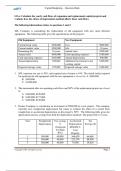Exam (elaborations)
Capital Budgeting Level 2 Q bank
O.a: Calculate the yearly cash flows of expansion and replacement capital projects and evaluate how the choice of depreciation method affects those cash flows. The following information relates to questions 1 and 2. SZL Company is considering the replacement of old equipment with new more eff...
[Show more]



